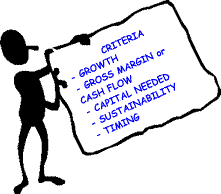 Membership
- 5 to 7 folks Membership
- 5 to 7 folks
Should the boss be on the team? Sure, ask them.
Have a leader (and maybe a facilitator) who will run
the meetings.
The team should be a mix of aligners (efficiency) folk
and adapters (innovative) folk. Shift the balance too
far on either side; the results suffer. There must be
one person focus on positioning the team to improve its
profits.
Most important, the team members must also be
responsible for implementation.
If you are getting too big, rather than increasing membership,
invite folks to present their issues to the team.
Have a good note taker (often a non-voting member).
Add youngsters with lots of customer contact
to participate or invite your customers.
Options or Hidden Agendas - Focus on Options
The team leader must manage the team dynamics to encourage
learning, challenge, foster communications and result
in innovations. You must consider alternatives.
Strategic planners identify options and make decisions.
But since the future is not predictable, these decisions
will be modified as the script plays out. It is very
hard to optimize the process into a few simple steps.
 A
winner takes all attitude, a hidden agenda, a we're sophisticated and you're provincial, or aggressive
advocacy for a position is less effective than considering
a variety of options and working together to discover
the best solution. A
winner takes all attitude, a hidden agenda, a we're sophisticated and you're provincial, or aggressive
advocacy for a position is less effective than considering
a variety of options and working together to discover
the best solution.
A good planner shares data, knowing that no one has
perfect insight about the future. They want to increase
the information available.
The team must consider options. My experience is four
is best. Just a few and you are not thinking critically,
and more than four gets too complicated. So be willing
to throw out losers early.
 Criteria, Facts and Customers Criteria, Facts and Customers
Agree to seek facts and keep assumptions to a minimum.
Agree you decision criteria before you begin debating
the options. Keep you criteria crisp: usually a sustainable growth rate,
gross margin, capital needs, sustainability and timing.
Non-profits use surplus rather than gross margin; government
planners use budget, tax or bond revenue.
There will be assumptions, so keep a list.
If a costly decision hangs on an assumption, then spend
money to find out the facts. Don't only look to the future; tell stories about what and why a decision went wrong in the past!
Under the pressure to finish, don't abandon the criteria
when there is little data. At the same time, don't seek
perfect knowledge. You'll never get there. When the facts
are skimpy, acknowledge it and move on.
The adage is "the customer doesn't know what they
need, we have to teach them." Ask the customer about
the desired outcomes, not their recommended solutions.
 Team
Dynamics Overview Team
Dynamics Overview |
|
Meeting Rules  |
|